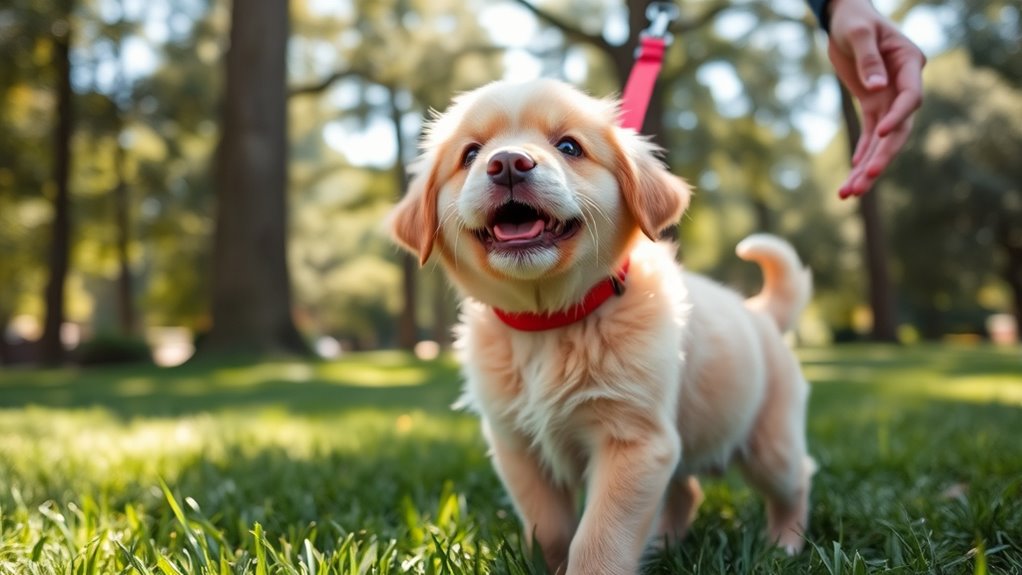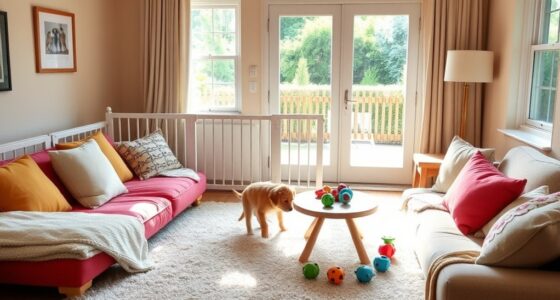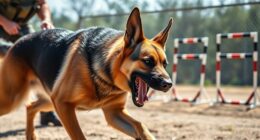To introduce your puppy to walks, start by choosing suitable equipment like a comfortable harness and a lightweight leash. Gradually get your pup used to wearing the gear indoors with treats and praise, then practice leash walking in calm, safe environments. Use positive reinforcement and basic commands like “sit” or “heel” to encourage good behavior. By easing your puppy into outdoor walks step by step, you’ll help build confidence and ensure enjoyable outings ahead. Keep exploring more tips to make training smoother.
Key Takeaways
- Gradually introduce the harness and leash indoors with treats and praise to build comfort and positive associations.
- Start with short, calm outdoor walks in quiet areas, using treats to reinforce good leash behavior.
- Use positive reinforcement and gentle corrections to teach commands like “sit,” “stay,” and “heel” during walks.
- Keep initial outdoor sessions brief and gradually increase duration as your puppy gains confidence.
- Ensure a proper leash fit, use durable equipment, and create a calm environment to foster safe, enjoyable walks.
Choosing the Right Equipment for Your Puppy
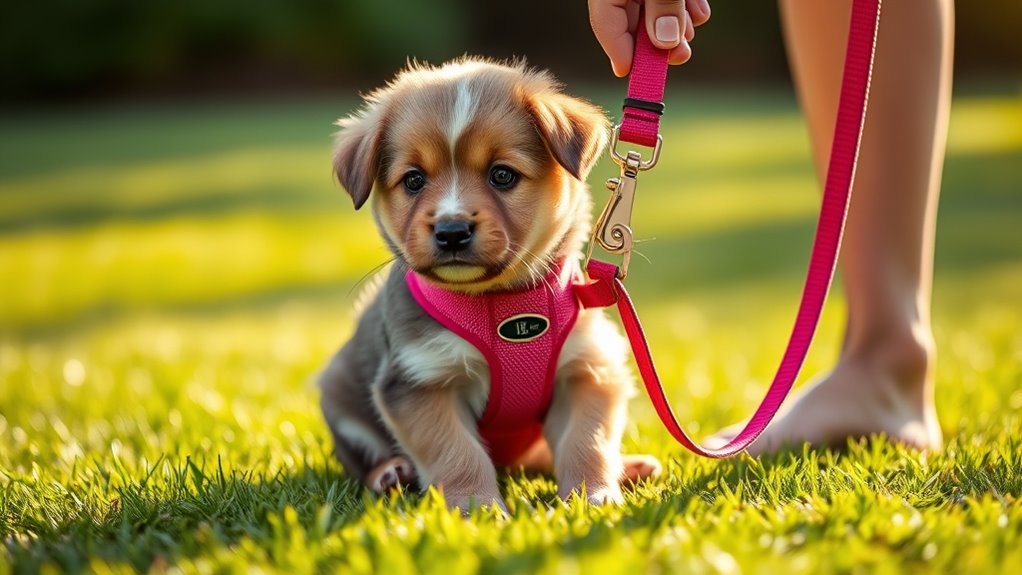
When selecting equipment for your puppy, it’s important to choose items that fit well and suit their size and temperament. Start with harness styles: options include back-clip, front-clip, and step-in designs. Each style offers different control and comfort levels, so pick one that matches your puppy’s activity and behavior. For collar materials, consider durability, comfort, and safety. Leather collars are sturdy and comfortable, while nylon options are lightweight and affordable. Avoid collars that are too tight or too loose, as they can cause discomfort or escape. Proper fit is vital to prevent choking or irritation. Additionally, choosing the right exfoliation level can be beneficial for your puppy’s skin health, especially if they have sensitive skin or are prone to irritation. Selecting the appropriate leash type ensures better control and safety during walks. Ensuring your puppy’s gear is properly fitted can help prevent injuries and make walks more enjoyable. Using durable materials for your puppy’s harness and collar can also extend their lifespan and withstand active use. By selecting the right harness style and collar material, you ensure your puppy’s safety and comfort during walks, setting a solid foundation for successful leash training.
Picking the Perfect Location for Initial Walks
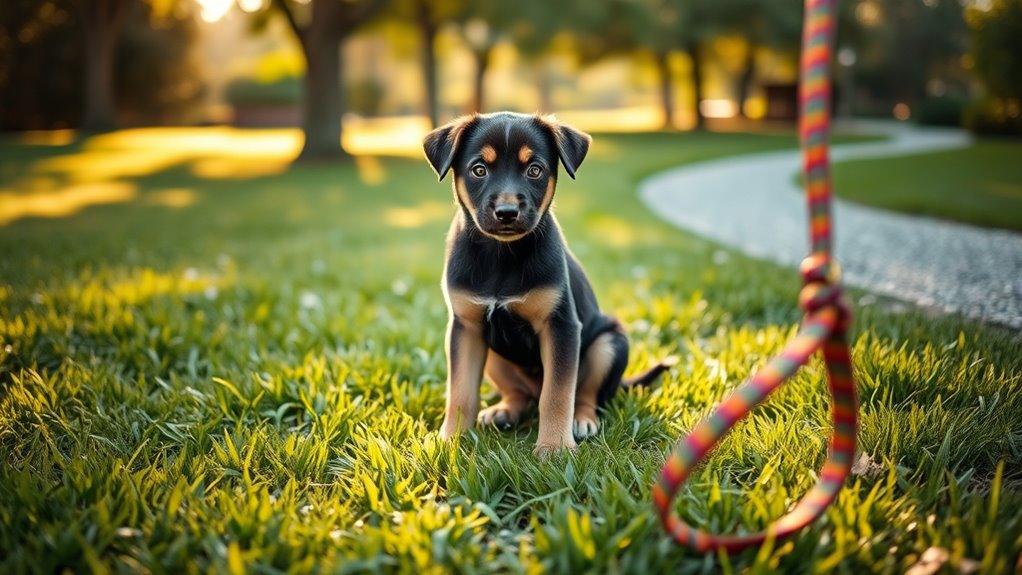
Choosing the right location for your puppy’s initial walks is essential to set a positive tone for training. You want a spot that’s calm and safe, helping your pup feel comfortable. A favorite park with open spaces can be perfect, giving your pup room to explore without too many distractions. Alternatively, a quiet street offers a low-stress environment, ideal for focusing on leash manners. Use the table below to compare these options:
| Favorite Park | Quiet Street |
|---|---|
| Spacious, open area | Less crowded, peaceful |
| Natural surroundings | Minimal distractions |
| Good for socialization | Easier to control environment |
| May have more distractions | Quieter, simpler setting |
Creating a positive association with the environment during walks can significantly enhance your puppy’s development, especially when considering dog training principles that emphasize positive reinforcement. It’s also helpful to start in environments that match your puppy’s comfort level to build confidence gradually. Additionally, choosing a location with predictable surroundings and minimal noise can help prevent overstimulation, making initial walks more enjoyable and effective.
Making Your Puppy Comfortable With the Leash

Start by choosing a leash that’s comfortable for your puppy and easy to handle. Use treats and praise to create positive feelings whenever they interact with the leash. This approach helps your puppy associate the leash with good experiences, making them more at ease during walks. Additionally, practicing leash training in a safe environment can boost your puppy’s confidence and reinforce good behavior. To further support their progress, consider budgeting tips to allocate resources for quality training supplies and treats, ensuring a consistent and effective training routine. Understanding narcissistic traits in humans can help you remain patient and calm during training, especially if your puppy exhibits any challenging behaviors. Incorporating positive reinforcement techniques can accelerate their comfort and cooperation with the leash. Being aware of best training practices can also help you adjust methods for your puppy’s unique personality and needs.
Choosing the Right Leash
To help your puppy feel at ease with a leash, selecting the right one is essential. Start by considering different collar types, such as flat collars or harnesses, to find what fits comfortably without causing discomfort. For leash lengths, choose a shorter leash, around 4 to 6 feet, to give your pup enough freedom while maintaining control. A longer leash, like 10 or 15 feet, can be useful later but might be overwhelming for beginners. Make sure the leash is lightweight and easy to hold, encouraging your puppy to feel secure during walks. Avoid leashes that are too heavy or stiff, as they can hinder your puppy’s comfort and confidence. Picking the right collar type and leash length sets a strong foundation for positive leash experiences. Using a lightweight and flexible leash can also help reduce strain and make walks more enjoyable for both you and your pup. Additionally, choosing a comfortable collar or harness can prevent chafing and improve your puppy’s overall walking experience. Incorporating proper leash training techniques early on can further enhance your puppy’s confidence and obedience during walks. Being aware of Bitcoin IRA options can also help you plan for future financial security, much like preparing your puppy for successful walks.
Creating Positive Associations
Creating positive associations with the leash is essential for making your puppy feel comfortable and confident during walks. Start by letting your pup explore the leash without any pressure, rewarding calm behavior with treats. This helps treat separation anxiety and builds trust. Use gentle, consistent cues and praise when your puppy remains relaxed around the leash. Understanding puppy body language is key; watch for signs of stress like tucked tail or stiff posture, and pause to comfort your pup if needed. Gradually introduce leash walks indoors before heading outside, always rewarding calmness. Avoid forcing your puppy; instead, create a calm environment that encourages curiosity and confidence. Additionally, being aware of cheating behaviors can help identify if your puppy is feeling overwhelmed or anxious, enabling you to adjust your training approach accordingly. Recognizing signs of overstimulation can also guide you in pacing the training sessions to prevent your pup from becoming overwhelmed. Incorporating positive reinforcement techniques further strengthens your puppy’s trust and enjoyment during training. Creating calm environments can also help your puppy associate walks with relaxation and safety. Incorporating appropriate treats can enhance your puppy’s motivation and willingness to engage during leash training. Over time, these positive experiences will help your pup associate the leash with safety and fun.
Encouraging Your Puppy to Walk on a Leash Indoors

Start by helping your puppy become comfortable with the leash equipment, letting them sniff and explore it. Use positive reinforcement, like treats and praise, to encourage calm behavior when introducing the leash. Gradually encourage your puppy to walk with the leash indoors, keeping sessions short and rewarding their efforts. Remember that puppy training techniques can influence how your puppy perceives and responds to different cues during training. Incorporating consistent leash training methods can help establish a positive routine and build your puppy’s confidence during walks.
Familiarize With Leash Equipment
Introducing the leash equipment gradually is key to making your puppy comfortable indoors. Start by allowing your pup to explore the harness and leash at their own pace. Let them sniff and nibble on the harness to build comfort, focusing on harness comfort to guarantee it fits snugly without causing discomfort. Attach the leash and let your puppy walk around freely indoors, encouraging gentle movement. Keep the leash length short initially to maintain control while preventing your puppy from feeling restricted. Allow them to get used to the feel of the leash and harness together, rewarding calm behavior. This slow familiarization helps your puppy associate the equipment with positive experiences, making outdoor walks more enjoyable later on.
Use Positive Reinforcement
Using positive reinforcement is essential to encourage your puppy to walk calmly on a leash indoors. When your pup stays close and walks politely, reward them with treat rewards to reinforce good behavior. Keep treats handy and offer them immediately after your puppy maintains a relaxed pace or responds correctly to your cues. If your puppy pulls or gets distracted, use gentle corrections to redirect their attention without harshness. Consistency is key—praise and treat whenever they walk nicely, helping them associate calm walking with positive outcomes. Over time, your puppy will learn that walking politely on a leash indoors leads to rewards, making future outdoor walks smoother and more enjoyable. Patience and positive reinforcement will build your puppy’s confidence and good leash manners.
Practicing Basic Commands to Assist Leash Training
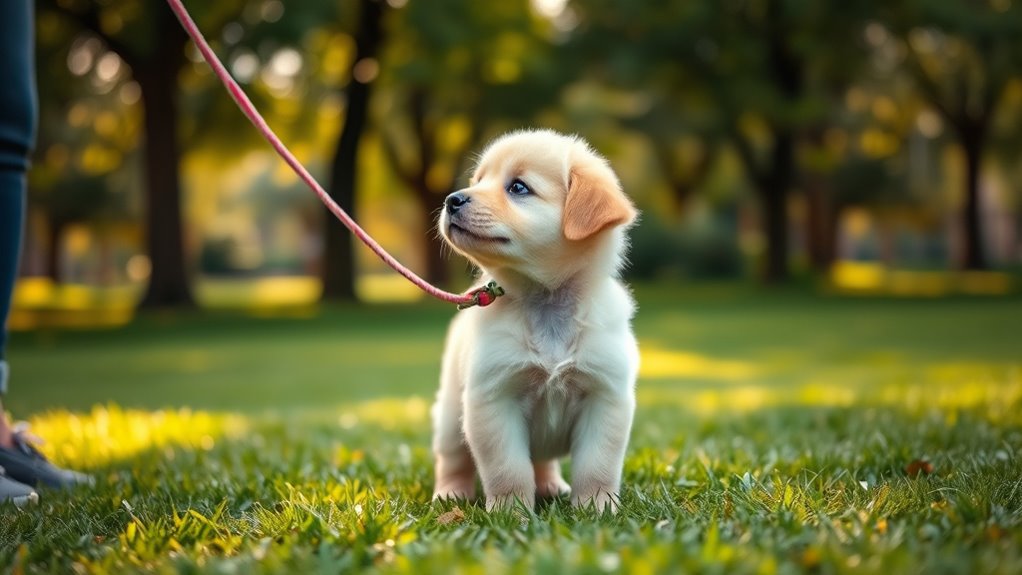
Practicing basic commands like “sit,” “stay,” and “heel” is essential for successful leash training because they establish your puppy’s understanding of cues and improve their responsiveness. Using techniques like clicker training can reinforce these commands effectively. When your puppy responds reliably, it boosts their confidence and promotes good leash etiquette. To strengthen these skills, try:
- Reinforcing commands during walks
- Using treats to reward quick responses
- Practicing in low-distraction environments
- Keeping training sessions short and consistent
- Incorporating commands into daily routines
These steps help your pup associate commands with behavior, making leash training smoother. Consistent practice ensures your puppy learns to walk politely and attentively, setting a solid foundation before outdoor adventures.
Gradually Introducing Your Puppy to the Outdoors

Building on the foundation of commands you’ve practiced indoors, it’s time to gently expose your puppy to the outdoors. Start with short, supervised outings in quiet, safe areas to promote puppy socialization and build confidence. Keep the first sessions calm and positive, allowing your pup to explore at their own pace. Use a lightweight leash to maintain control while giving them the freedom to sniff and observe their environment. Always prioritize outdoor safety by avoiding busy streets, toxic plants, or other hazards. Gradually increase the duration and complexity of outings as your puppy becomes more comfortable. Consistent, gentle exposure helps prevent fearfulness and ensures your puppy learns to enjoy outdoor walks safely.
Using Positive Reinforcement to Promote Good Behavior
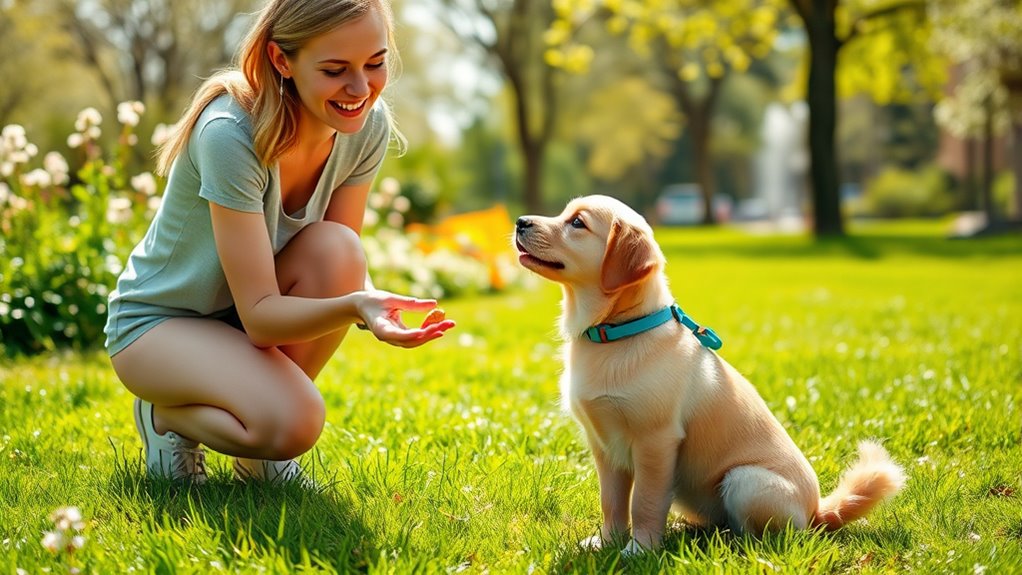
Positive reinforcement is one of the most effective ways to encourage good behavior in your puppy. When they walk nicely on the leash, reward them immediately with treat rewards or verbal praise. This helps your puppy associate good behavior with positive outcomes. Consistency is key; always reward desired actions to reinforce learning. You can:
- Give treat rewards right after your puppy walks calmly
- Use verbal praise like “Good job” enthusiastically
- Offer treats for staying close and focused
- Praise when they stop pulling or lunging
- Use treats and praise together for added motivation
This approach builds confidence and trust, making leash training more enjoyable for both of you. Remember, patience and consistency turn good behavior into habits that last.
Managing Common Challenges During Leash Training
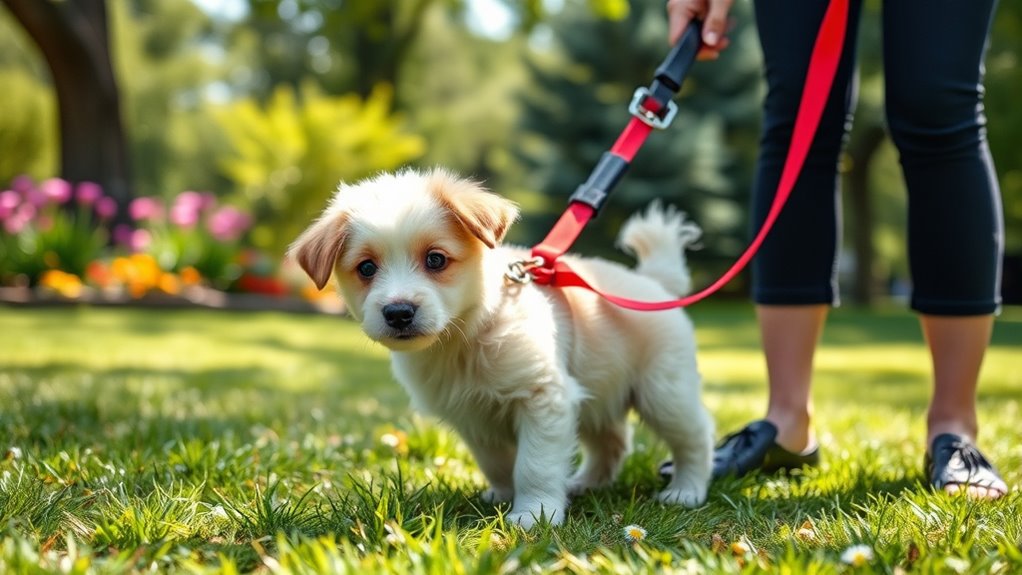
Managing common challenges during leash training requires patience and quick problem-solving. If your puppy pulls on the leash, gently stop walking and call them back to your side, rewarding when they return. Consistently counteracting pulling helps them learn to walk calmly. When managing distractions, stay focused and redirect your puppy’s attention with treats or toys. If they become fixated on something, calmly lead them away or pause until they refocus on you. Keep training sessions short and positive to prevent frustration. Avoid pulling or yanking, which can make issues worse. Always reward good behavior to reinforce calm walking. By staying consistent and patient, you’ll help your puppy overcome these common challenges and develop better leash manners over time.
Building Confidence and Establishing a Routine

When your puppy begins to master leash manners, establishing a consistent routine and boosting their confidence become key to ongoing progress. A steady schedule helps your puppy feel secure and understand what to expect, reinforcing their socialization skills. To build confidence and create a positive walking experience, consider:
- Keeping walks at a comfortable pace
- Gradually introducing new environments
- Rewarding calm behavior consistently
- Practicing short, regular outings
- Using praise to encourage exploration
These steps help your puppy feel more confident and comfortable on walks. Routine provides predictability, making training more effective. Focus on socialization skills with friendly encounters, and celebrate small victories to foster confidence. This foundation ensures your puppy is enthusiastic to learn and enjoy leash walks.
Frequently Asked Questions
How Long Should My Puppy Wear the Leash During Initial Training Sessions?
You should start by keeping your puppy on the leash for short, focused sessions, around 5-10 minutes, to prevent frustration. Use leash accessories that are comfortable and safe, ensuring your pup feels secure. During these sessions, focus on puppy socialization and gentle leash training. Gradually increase the duration as your puppy gets more comfortable, always ending on a positive note to build confidence and trust during walks.
What Are Signs That My Puppy Is Ready for Longer Outdoor Walks?
Like a sprinter ready for the race, your puppy shows signs when they’re ready for longer walks. Watch for confident leash walks, calm behavior around other dogs, and curiosity about their surroundings. These are key moments in puppy socialization. Make sure they’re comfortable with leash accessories and not overly distracted or anxious. When they walk steadily without pulling or fussing, it’s a good sign you can extend your outdoor adventures together.
How Can I Prevent My Puppy From Pulling on the Leash?
To prevent your puppy from pulling, focus on consistent leash training and using appropriate accessories like a harness or gentle leader. Keep sessions positive and short, rewarding good behavior with treats. Incorporate puppy socialization to build confidence and reduce pulling out of fear. Stay patient, and if your pup pulls, stop walking until they relax. Over time, these techniques help your puppy learn to walk calmly by your side.
When Should I Start Introducing Distractions During Leash Training?
Think of leash training like planting seeds—you want to introduce distractions gradually as your pup’s attention blossoms. Start incorporating mild distractions when your pup hits early training milestones, such as walking beside you calmly. As their focus sharpens, gently raise the distraction levels. This steady progression helps your pup stay engaged and responsive, turning walks into enjoyable adventures rather than chaos, and ensuring they’re prepared for more stimulating environments.
How Do I Handle Leash-Reactive Behaviors Like Barking or Lunging?
When your puppy shows leash-reactive behaviors like barking or lunging, stay calm and avoid punishment. Focus on puppy socialization by gradually exposing your pup to different environments, rewarding calmness with treats. Practice leash manners consistently, keeping walks short and positive. Use distraction techniques, like toys or commands, to redirect attention. Over time, this approach helps your pup learn appropriate leash behavior and builds confidence during walks.
Conclusion
Remember, leash training is a gentle dance that helps your puppy discover the world at their own pace. With patience and encouragement, you’ll both enjoy exploring new sights and sounds together. Each small step builds trust and confidence, turning walks into happy adventures. Embrace the journey, celebrate progress, and soon you’ll find that every outing is a delightful chapter in your puppy’s growth. Happy walking, and cherish these precious moments along the way.

